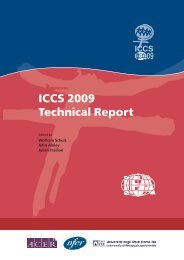Teacher Education and Development Study in Mathematics - IEA
Teacher Education and Development Study in Mathematics - IEA
Teacher Education and Development Study in Mathematics - IEA
You also want an ePaper? Increase the reach of your titles
YUMPU automatically turns print PDFs into web optimized ePapers that Google loves.
PART 2: ITALY<br />
107<br />
<strong>Teacher</strong>s can also raise their salaries by tak<strong>in</strong>g on special tasks <strong>and</strong> responsibilities<br />
with<strong>in</strong> the school (such as for assessment <strong>and</strong> evaluation, school–family relationships,<br />
<strong>and</strong> department co-ord<strong>in</strong>ation). The school pr<strong>in</strong>cipal assigns these responsibilities<br />
accord<strong>in</strong>g to decisions made by the School <strong>Teacher</strong> Council.<br />
Relative to other OECD member countries, teachers <strong>in</strong> Italy earn lower than average<br />
salaries at all levels. At the lower-secondary level, for example, beg<strong>in</strong>n<strong>in</strong>g Italian teachers<br />
<strong>in</strong> 2003 earned $US25,602, compared to the OECD average of $26,241 (us<strong>in</strong>g purchas<strong>in</strong>g<br />
power parity). <strong>Teacher</strong>s <strong>in</strong> Italy with 15 years of experience <strong>and</strong> m<strong>in</strong>imum tra<strong>in</strong><strong>in</strong>g<br />
earned $31,304 compared to the OECD average of $35,876. Consequently, while OECD<br />
beg<strong>in</strong>n<strong>in</strong>g salaries were only 2% higher than those of Italian teachers, OECD teachers<br />
with 15 years of experience earned almost 15% more than Italian teachers with the same<br />
degree of experience <strong>and</strong> tra<strong>in</strong><strong>in</strong>g (OECD, 2005). However, because Italian teachers<br />
typically work a lower number of hours than the OECD average, they actually compare<br />
relatively well with OECD <strong>and</strong> European Union (EU) teachers <strong>in</strong> terms of hourly wages.<br />
In fact, beg<strong>in</strong>n<strong>in</strong>g Italian teachers <strong>in</strong> 2000 earned more per hour ($37) than the OECD<br />
average of $32.60 <strong>and</strong> the EU average of $35.90.<br />
<strong>Teacher</strong>s’ salaries as a percentage of GDP per capita—a measure of the value of teachers<br />
relative to economy-wide resources—decreased between 1993 <strong>and</strong> 2000, <strong>in</strong>dicat<strong>in</strong>g<br />
an implicit devaluation of teach<strong>in</strong>g services <strong>in</strong> Italy over this period. For example, a<br />
start<strong>in</strong>g lower-secondary teacher <strong>in</strong> 1993 earned 1.07 times the GDP per capita, while a<br />
new teacher <strong>in</strong> 2001 earned 0.95 times the GDP per capita. At the same time, however,<br />
the real salaries of lower-secondary teachers <strong>in</strong>creased by 11% between 1996 <strong>and</strong><br />
2003, <strong>in</strong>dicat<strong>in</strong>g that, despite the decrease <strong>in</strong> relative salaries, absolute salaries actually<br />
<strong>in</strong>creased over this period (OECD, 2005).<br />
Although paid relatively low salaries, teachers <strong>in</strong> Italy compared to Italian workers <strong>in</strong><br />
the private sector enjoy many non-pecuniary benefits, <strong>in</strong>clud<strong>in</strong>g employment security,<br />
lower work<strong>in</strong>g hours than the European average, low student–teacher ratios, relatively<br />
good retirement benefits, <strong>and</strong> generally high maternity- <strong>and</strong> sick-leave protections.<br />
Moreover, accord<strong>in</strong>g to a 1994 poll of Italian public employees, teachers ranked highest<br />
<strong>in</strong> terms of the percentage (62.3%) of respondents with higher or average satisfaction<br />
regard<strong>in</strong>g their work<strong>in</strong>g conditions.<br />
In our analysis of the Survey of Italian Households’ Income <strong>and</strong> Wealth data, we could<br />
only estimate the earn<strong>in</strong>gs of <strong>in</strong>dividuals who were tra<strong>in</strong>ed as teachers, not those who<br />
worked as teachers. We compared these earn<strong>in</strong>gs to those of <strong>in</strong>dividuals tra<strong>in</strong>ed <strong>in</strong> other<br />
fields. Many older Italian (ma<strong>in</strong>ly primary) teachers only have secondary-level (normal<br />
school) education, which is one reason why Italian teachers seem to earn lower relative<br />
<strong>in</strong>comes compared to teachers <strong>in</strong> other OECD countries. However, <strong>in</strong> terms of today’s<br />
labor market, we need to focus on the comparative salaries of teachers with university<br />
education because that is the requirement young teachers must now meet. Thus, <strong>in</strong> the<br />
tables below (31 <strong>and</strong> 32), we show the salaries of <strong>in</strong>dividuals tra<strong>in</strong>ed as teachers at the<br />
secondary <strong>and</strong> university level compared to the salaries of <strong>in</strong>dividuals tra<strong>in</strong>ed <strong>in</strong> other<br />
fields. However, <strong>in</strong> the graphs (Figures 34 to 37), we compare only those <strong>in</strong>dividuals<br />
tra<strong>in</strong>ed at the university level.

















